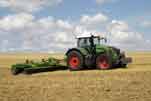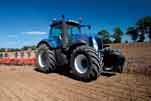First Drive: JCB 7270 tops Fastrac range
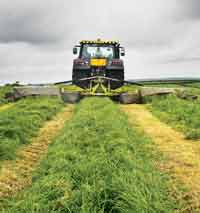
The 7270 is the latest – and biggest – model to join JCB’s Fastrac 7000 line-up. Emily Padfield visited Carmarthenshire contractor Davies Bros to see how the beefed-up model handled a set of triple mowers
When JCB launched the three models in its new 7000 series last year, the intention was always to have a fourth, too. That duly appeared at the Paris show in February this year and is now out and about in the UK.
With a beefier turbo, hydraulically damped flywheel and tweaked transmission, the 7270 – rated at 270hp – now means the 7000 range extends from 170-270hp.
But it’s not a replacement for the larger CVT 8250, which is rated at a similar-sounding 280hp, says JCB’s Edward Roach. More, it’s a case of taking the 7000 range up to the horsepower level people want from this size of tractor.
In fact it is aimed squarely at the contractor market, with a beefy 990Nm of torque on tap for big equipment. Because this is a torquey tractor, it should be ideal for cultivation jobs and running kit like triple mowers, big balers and drills.
Its on-the-road capabilities – as you’d expect from a Fastrac – are strong and the 70kph top speed mean less time getting from job to job.
Power on this new model comes from the same 6.7 Cummins diesel powerplant found in the other three models. It is mated to the same four-range powershift transmission, too, though some of the transmission settings have been tweaked.
While previous Fastracs had four equally-sized wheels, the 7000 edges much more towards a conventional tractor layout like its bigger 8250 brother. JCB has tried to maintain the 50:50 weight distribution (standard tractors are more like 40:60), but, because they have shifted the cab back and used bigger rear wheels, they have compromised at a 47:53 figure.
The idea behind the 7000 range was always to turn the Fastrac into a capable draft tractor as well as a good transport machine. One of the key ways of doing that was to design a new chassis layout, which boosts the 7000’s weight to 9.5t compared with the 7.8t of the Fastrac 3000 range.
The 3000 range has a ladder-type chassis, with two bars coupled to cross members. That’s good for haulage, but not so great in the field. So the new contoured chassis aims to give it the draftwork-friendly capabilities of conventional tractors and solve the steering problems which users identified in the 3000 series.
Incidentally, both front and rear axles are the company’s own ones, built at its Wrexham factory, while the front axle hubs are from the 8000 range.
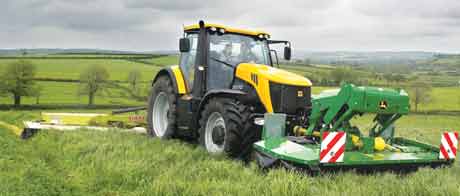
In the field
There is a distinctive sound to a set of triple mowers, a little like a helicopter hovering at low level. Coupled with the throaty roar of the 7270, and perched on a remote Welsh hillside, it makes for quite an impressive spectacle.
We hooked up to a JD131 front-mounted mower with a pair of Claas Disco 8550 Cs on the back. Why the mixed-make set-up? Apparently, says the contractor, it’s ideal for this sort of rough hillside.
Getting started is simple. Engage the pto, then select forward and reverse, either via the standard steering wheel-mounted shuttle or using the chunky joystick.
When you start up, the screen flashes up a picture of the joystick, telling you what each of the four black buttons is programmed for. Re-programming is simple: Push the joystick option and choose which you would rather have.
The next screen shows which transmission option you’ve selected – Powershift, Auto or Drive. Powershift is the obvious choice for mowing.
For this task, lift and lower spools were configured for the middle buttons, meaning it was just an up-and-down selection job at each headland. Changing drive mode means hitting the green button on the top of the joystick, while the white button on the left is your headland management system.
JCB’s new headland management system is simple to operate. We weren’t able to use it to lift the mowers at each headland, as the models we had weren’t able to be hooked up. However, the programming sequence is straightforward, with large touchscreen buttons guiding you through the process.
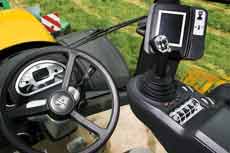 |
|---|
| Above: Cab is biggest on the market. Below: Radiators are easy to get to. There is also a ground-level service area with battery, engine oil dipstick and screenwash filler |
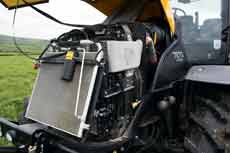 |
You can either choose between a fully automatic sequence or activate each step by pressing a button. There are five presets, too, each with the option of 15 steps. Shame you are not able to record a sequence, though, or preset throttle speeds.
Front and rear self-levelling suspension makes for rapid travel, even over fields which may have escaped a going-over with the rolls in the spring. The whole 7000 range gets the hydro-pneumatic treatment, rather than the rear hydro-pneumatic and front coil setup featured on the 3000 series.
While the tractor is adjusting itself – for example, if you are lifting the mowers or ending a land – the suspension feels a little like that of a Land Rover Discovery. It’s essentially doing the same sort of thing – constantly adjusting to maintain the optimum weight distribution.
Incidentally, the 7000 series models lift 9.1t rather than the 8t of the 3000 range.
Does the extra hp make a difference? It certainly felt so and the tractor hardly grunted when faced with rolling hillside and cutting damp grass. But while the 9.5t machine is hardly sluggish, it is a big beast to get used to at the end of a bout.
On the road
The six-speed, four-range, fully clutchless semi-powershift 70kph box worked well on the road. The joystick arrangement is pretty easy to fathom – push to the right to go up a gear, push left to come down. A button on the front changes range and Drive mode gives full auto in C and D ranges.
Braking is predictably swift – all 7000s get larger front and rear outboard brake discs and twin callipers. They are all ABS-enabled, too.
Day-to-day maintenance
The cooling pack has easy access, with enough room to stick an air-line down both sides. Because the cab has been shifted backwards, there is more room under the bonnet and it has been made skinnier for turning circle and visibility.
A handy ground-level service area, under the non-opening right-hand door, houses all the essentials and service intervals have been lengthened to 2000 hours for hydraulic, 500 hours for engine and 1000 hours for transmission oils.
In the cab
The one-door cab (it’s a pressurised system to eliminate dust) has acres of glass and the narrowed console gives better visibility for cultivation and forage-orientated work. Full climate control coupled with 12 air vents means the big cab shouldn’t turn into the agricultural equivalent of the Eden Project.
There is a distinct lack of overcrowding in the cab, too, and an almost Grand Designs sense of minimalism. Spools and linkage controls are mounted on a heavy-duty pod on the arm rest and most of the controls nestle within range of the touchscreen system.
FW verdict
JCB has obviously put a lot of thought into the 7000 range to boost its versatility and make it a proper contender for draft work as well as transport tasks. The larger 7270 boosts the appeal of the range further, making it a real candidate for larger farmers and contractors looking to up their workload and shift between jobs rapidly. The headland management system may not have quite as many high-tech bells and whistles as some, but the engine has plenty of grunt and it’s a very big cab.
| What’s new? • Increased hp – up to 270hp • Larger turbo • Hydraulically dampened flywheel on engine • Different transmission calibration |
|---|
| THE RIVALS | ||
|---|---|---|
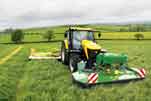 | 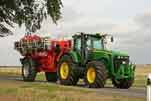 |
|
| JCB 7270 Fastrac 270hp £106,400
| John Deere 8230 Autopower 270hp £107,090 | Fendt 927 Vario 270hp £168,072
|
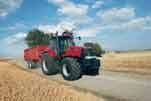 | 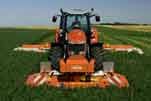 |
|
| Case Magnum 250 285hp £93,864
| Massey Ferguson 8650 Dyna-VT Excellence 270hp £141,426 | New Holland T8020 Ultra-command 281hp £102,524
|

